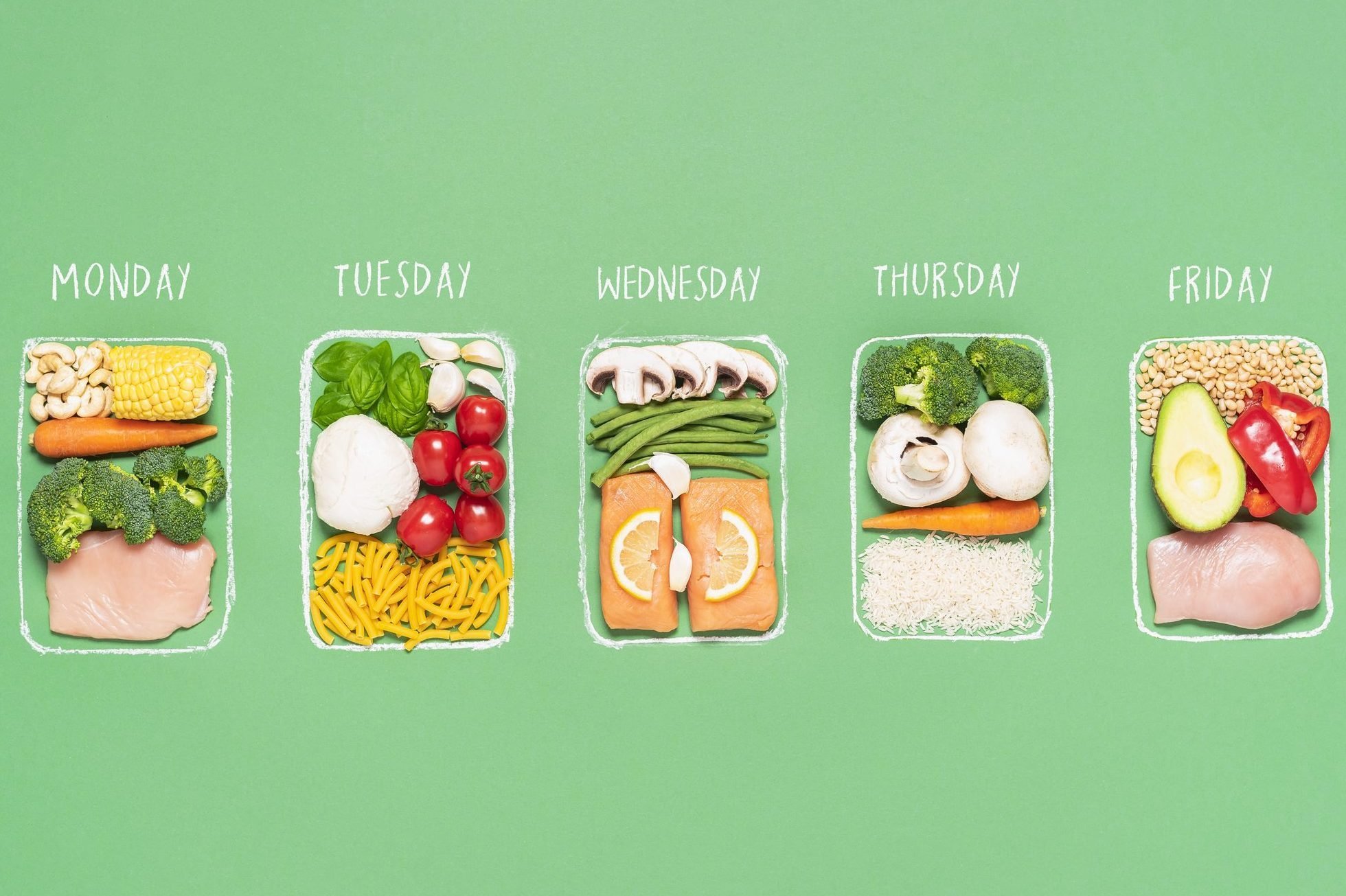An hour of meal planning each week saves me about $500 a month. Here's how I do it.

I Meal Plan Every Week—and It Saves Me Thousands of Dollars a Year

With a family of five (soon to be six), life is both chaotic and expensive. Eating out is the easiest option when you consider our various schedules and differing tastes. But all those restaurant trips and takeout orders add up quickly. To make sure I stick to our budget and still keep things relatively easy, I started meal planning about two years ago.
The concept is fairly simple: When meal planning, you decide on a week’s worth of meals in advance. You can make decisions based on your schedule, your family’s preferences, the foods you have on hand or what will be on sale at your local grocery store that week. Once you’ve selected your meals, take a look at the recipes for each and make a budget grocery list based on the ingredients you’ll need. It took a few weeks to figure out a system that worked best for our family, but since working out most of the kinks, I find that we eat healthier on a budget, have less food waste in our home and save, on average, around $500 a month.
If my savings make it sound like I’m doing something extreme, I assure you I’m not. I go to only one grocery store and don’t bother with coupons. Sure, I know the basics of how to coupon, but my Sunday circulars are filled with more deals on beauty and cleaning products than food. And I don’t have the will or the time for extreme and complicated ways to save money. Instead, I focused on how to save money on groceries without coupons, and meal planning has been my go-to trick.
Get Reader’s Digest’s Read Up newsletter for humor, cleaning, travel, tech and fun facts all week long.
Why meal planning works for me
What makes meal planning so great is that it cuts down on the number of grocery trips I need to make and keeps me on budget. I make a single trip to the store with a list of exactly what I need to make the meals I have planned for the week. And when I stick to that list—even if I throw a few extra items in my cart (which I always do)—I still tend to stay anywhere between $125 and $150 under budget. It may not make me a saver worthy of the FIRE movement, but it does make a difference to my bank account.
If I don’t meal plan, I wander aimlessly through the grocery store, trying to decide what I want to cook while attempting to make a shopping list from memory. In those rare instances, I end up spending almost my entire weekly budget, and I always end up back at the store because I forgot a few things. That said, while meal planning saves me a ton of money and takes the guesswork out of determining what’s for dinner, it’s still not a perfect system by any means.
Though our family has a tried-and-true rotation of favorite meals, I have three young children who may like pork chops one day and hate them the next. There are mornings when I forget to take the chicken out of the freezer and afternoons when I open a package of ground beef and find it smells rancid. And there are days where I’m just not in the mood for whatever is on the menu that night. But rather than pick up the phone and order a pizza, which no one in my family really likes anyway, I always have a few easy, crowd-pleasing options on hand.
On these nights, I’ll whip up breakfast for dinner—it’s such a staple that I keep buttermilk for pancakes in my fridge and bacon or sausage in my freezer. Or I’ll offer my children fun food like chicken nuggets, ravioli and pasta with butter while throwing together egg or chicken salad sandwiches for me and my husband. Of course, there are the nights when I want absolutely nothing to do with the kitchen, so my husband grabs Chick-fil-A on his way home from work. And since meal planning saves us so much money each week, I feel zero guilt about the occasional fast-food night.
Meal planning might sound like a lot. After all, how are you supposed to know on Sunday what you’ll want for dinner on Thursday? How do you keep track of it all? Will you be stuck in the kitchen every single night? What if you have picky eaters in your family? It’s a lot to think about, and it may take a bit of trial and error before you find what works for your family. But flexibility is just another great thing about meal planning. Read on for the best tips and tricks to make meal planning a success.
How to meal plan

If you love the idea of saving money and spending less time wandering the aisles of your grocery store, it’s time to give meal planning a try. The tips below are a smart place to start. And the more you meal plan, the more you’ll hone your process, landing on a simple strategy for designing a weekly menu.
Look at your schedule
What does each day of the week look like for you? You may have the time to cook a meal from scratch on the days when everyone is home at their normal time. But days when you have afternoon appointments, meetings or extracurricular activities may be better suited to a Crock-Pot or Instant Pot meal.
I should know. Two days each week, I either don’t get home until 5 p.m. or I run out the door at 6 p.m. to chauffeur my children to one lesson or another. On those days, I’ll plan something fast (like tacos or an Instant Pot dinner) or serve up leftovers.
Don’t forget to dedicate one day each week to meal planning. I set aside time every Sunday to plan, shop and prep.
Plan your meals
It may take some time to figure out the best meal-planning method for you. If you’re stumped by what to make for dinner, ask your family for suggestions, go with your favorites or look for recipes that will best fit your schedule, skill level or budget. (Pro tip: When you come across a recipe that sounds delicious, add it to a designated Pinterest board, then review saved recipes when planning meals for the week.)
I always begin by taking inventory of my pantry, fridge and freezer and start planning from there. (This is where fridge organization really comes in handy, by the way.) For example, if I have ground turkey in the freezer, eggs in the fridge and breadcrumbs in the pantry, I’ll plan to make baked turkey meatballs one night, adding the missing ingredients to my shopping list. I have a collection of recipes I’ve accumulated over the years that my family likes to cycle through, and I’ll usually ask for their input before I finalize the menu.
I also factor in at least one leftover night each week. This gives me a night off from cooking and reduces food waste. And when it’s time for something new, I’ll peruse the internet for inspiration. Whether you’re looking for simple dinner ideas, 30-minute meals or restaurant copycat recipes, there’s no shortage of online inspiration.
Once I’ve decided which meals I’ll be making, I write them down on this inexpensive magnetic menu and put it on the fridge so the rest of my family knows what to expect.
Make your shopping list
Once you’ve made your menu for the week, it’s time to create a shopping list. Scan the recipes to determine which ingredients you already have and which you’ll need to buy. This is also a great time to restock anything you might be running low on. Since I plan my menu based on what I already have in my fridge or freezer, my lists are usually pretty short.
Go shopping
I used to scour my local grocery stores’ weekly flyers to see which had the best sales that week. Usually, that resulted in my visiting at least three grocery stores in a day. I was saving money on certain food items, but driving all over the place just wasn’t worth it.
Now, I do the majority of my shopping at Aldi, stopping at the big-name grocery store across the street for any remaining items. (Bonus: By shopping primarily at a single low-priced grocery store instead of driving from one store to the next, I save money on gas.)
Wherever you shop, be sure to bring your shopping list with you and do your best to purchase only the items on your list.
Prep what you can
Pick a day and time that works best for food prep. Depending on your menu, this could involve defrosting meat or chopping veggies in advance. You can also use it to prep lunches for the week.
On Sundays, I make a batch of grilled chicken and sheet pan vegetables that my husband and I can have for lunch throughout the week. The chicken can also be used for soups, salads, quesadillas or whatever else you may have planned. I also boil a carton of eggs to have in the fridge for a quick breakfast or snack option; they’re also useful for easy-to-make egg salad, a simple but filling lunch.
Just be sure you store your food properly so it doesn’t go bad.
Get cooking
Heading into the week with a menu plan and all the ingredients on hand can make dinnertime rather enjoyable. After all, you don’t have to deal with the stress of figuring out what to eat and won’t need to make a last-minute trip to the store because you’re missing key ingredients. And the more you meal plan, the easier it becomes.
So even if you find the first couple of weeks time-consuming or troublesome, stick with it! Eventually, you’ll figure out what works best for you and your family.
Meal-planning tips
To save even more on food and keep mealtime fresh, try some of these meal-planning tricks.
- Scan store circulars for coupons (just because it’s not my process doesn’t mean it won’t work for you!), or plan your weekly menu around what’s on sale that week.
- Download your favorite grocery store’s app, if it has one. This can give you extra savings or even recipe ideas.
- If you want to save even more money, be sure you know how to find coupons.
- Double your favorite recipes and plan to have at least one leftover night each week. These food storage containers will help keep them fresh.
- Incorporate a theme night or two into your weekly menu to keep dinnertime exciting. Meatless Mondays, Taco Tuesdays and Pizza Fridays are easy options.
- Plan your menu around what’s in season. We do a lot of burgers in the summer and soups or stews in the winter.
- Have a backup plan in case something goes awry. I always keep pie crust in the freezer for quiche, for instance. And leftover chicken is perfect for a quick chicken soup.
- Plan a single meal per night—not different dishes for each person. I have picky eaters, so I know how hard (if not downright impossible) it can be to please everybody. But I won’t make several different meals each night. That said, I do keep fast and easy kid-friendly food on hand and will make an alternative meal for them if I’m making something spicy.
Once you’ve mastered meal planning, look for other ways you can save—or make—money in your daily life. Budget apps, for instance, simplify the process of saving—without a ton of work. The right side hustle idea can bring in pocket money. And learning how to negotiate can do both, winning you more money or a lower price.






















